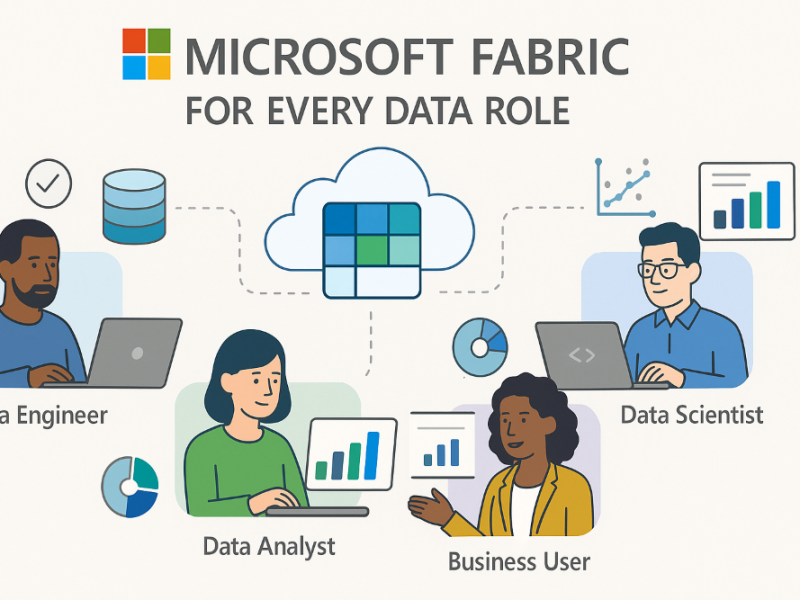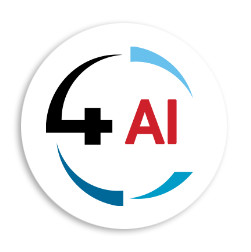Blog - Channel Partner
Microsoft Fabric for Every Data Role

Microsoft Fabric is an all-in-one analytics platform that brings together data movement, data science, data engineering, data warehousing, real-time analytics, and business intelligence. It’s designed to be used by a wide variety of data professionals—each with different responsibilities, workflows, and tools.
To make the most out of Microsoft Fabric, it's essential to understand how the platform caters to each of these roles. In this post, we’ll break down the core data roles—data engineers, data scientists, data analysts, data stewards, and data architects—and explore the specific features and capabilities Microsoft Fabric provides for each.
1. Data Engineers: Building the Backbone
Data engineers are responsible for building robust data pipelines, transforming raw data into formats that can be used by analysts and data scientists. In Microsoft Fabric, their toolbox is packed with functionality that lets them handle big data workflows efficiently and at scale.
Key Features for Data Engineers:
- Data Pipelines and Notebooks Engineers can build automated pipelines to ingest, transform, and move data. These pipelines can include Spark notebooks that allow code-based data transformations using PySpark, Scala, or SQL.
- Spark Job Definitions For handling large-scale data transformations, data engineers can define Spark jobs directly within Fabric. These jobs are highly scalable and can be reused across different projects and pipelines.
- Lakehouse and Data Warehouse CRUD Operations Fabric supports the Lakehouse architecture, combining the flexibility of data lakes with the structure of warehouses. Engineers can perform full CRUD operations on these environments to manage structured and unstructured data.
- Workspace Roles and Permissions Typically, data engineers are given Contributor or Member roles in workspaces. This allows them to create and manage items like pipelines, notebooks, and dataflows while also executing transformations and debugging jobs.
In short, Microsoft Fabric gives data engineers a modern, scalable environment to handle everything from raw data ingestion to prepped and ready analytics datasets.
2. Data Scientists: Modeling and Machine Learning
Data scientists need access to clean, enriched data and powerful computing resources for model development, training, and deployment. Fabric offers a robust suite of tools tailored to these tasks.
Key Features for Data Scientists:
- Integrated Notebooks Fabric provides collaborative notebooks with support for Python, R, and Scala. These can be used for data exploration, visualization, model training, and evaluation.
- ML Models and Experiments Scientists can create, run, and track experiments directly within the platform. Fabric also allows versioning of models and experiment parameters for easier iteration and auditing.
- Spark Processing for ML Workflows Microsoft Fabric's Spark environment supports large-scale machine learning, enabling the training of complex models using distributed computing.
- Workspace Access as Contributors or Members With the appropriate workspace roles, data scientists can modify and execute ML-related items and collaborate closely with engineers and analysts on shared datasets.
These features allow data scientists to streamline their workflows—from prototyping to production—all within a unified environment.
3. Data Analysts: Exploring, Visualizing, and Reporting
Data analysts focus on interpreting data, finding trends, and communicating insights. Microsoft Fabric supports this with features that simplify querying, visualization, and sharing results.
Key Features for Data Analysts:
- SQL Analytics Endpoints Analysts can write SQL queries against Lakehouse or Warehouse data using familiar syntax. This enables quick insight generation and ad-hoc analysis.
- Power BI Integration Microsoft Fabric tightly integrates with Power BI. Analysts can connect directly to datasets and build dynamic dashboards, charts, and paginated reports—all within the same workspace.
- Lakehouse Explorer This interface allows analysts to browse data assets, preview tables, and understand data structure before querying or building models.
- Viewer Workspace Role Data analysts are commonly assigned the Viewer role, which allows them to query data, run reports, and explore analytics without altering pipeline logic or configurations.
With these capabilities, analysts can focus more on delivering business value and less on worrying about infrastructure.
4. Data Stewards: Guarding Data Quality and Governance
Data stewards are responsible for data quality, compliance, and governance—critical for organizations that work with sensitive or regulated information.
Key Features for Data Stewards:
- Data Access Roles in OneLake Microsoft Fabric includes OneLake, the central data lake for all data assets. Stewards can define row-level and column-level permissions to ensure only the right people access the right data. This is essential for compliance and privacy.
- Metadata Management Fabric supports metadata tagging, lineage tracking, and documentation. Data stewards can ensure data assets are well-organized and discoverable through semantic descriptions.
- Monitoring Data Quality Using built-in tools or custom scripts, stewards can validate datasets against quality thresholds and monitor for anomalies.
- Contributor or Member Roles With these permissions, stewards can define policies, manage metadata, and ensure governance policies are correctly applied across the workspace.
For organizations where governance is non-negotiable, Fabric provides the structure and tooling to enforce it without disrupting collaboration.
5. Data Architects: Designing for Scale and Security
Data architects are responsible for designing the overall data infrastructure, ensuring scalability, reliability, and security.
Key Features for Data Architects:
- Workspace Creation and Management Architects can create workspaces for different departments or projects, assign roles, and control access at a granular level.
- Data Modeling Microsoft Fabric allows architects to define semantic models that feed into reports and dashboards. This ensures a single version of truth across the organization.
- Row-Level and Column-Level Security Architects can define and enforce data security policies, ensuring sensitive data is only accessible to authorized roles or users.
- Admin Workspace Role With full control over workspace configurations, security settings, and integrations, architects can ensure the environment aligns with enterprise architecture standards.
These tools empower architects to build future-proof systems that are flexible enough for innovation and structured enough for compliance.
Final Thoughts
Microsoft Fabric is not just a tool—it’s a platform designed for collaboration across the entire data lifecycle. By tailoring its capabilities to each data role, Fabric ensures that every professional—whether engineer, analyst, scientist, steward, or architect—has what they need to do their best work.
When everyone uses the same environment but has role-specific capabilities, collaboration becomes smoother, governance becomes tighter, and value delivery becomes faster. That’s the promise of Microsoft Fabric.
Whether you're just getting started or optimizing existing workflows, knowing how the platform supports each role is the first step to making smarter decisions and working more effectively as a data team. Reach out to us at This email address is being protected from spambots. You need JavaScript enabled to view it. to discuss your Microsoft Fabric needs.


